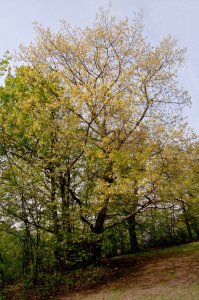
Red Oak (Quercus rubra)

| Occurrence in Děčín | Red oak grows in many parks as well as in greenery. The largest specimens can be found in Mariánské louka and in Kvádrberk (482 and 480cm). Other large specimens can be found in the U Kaple Forest Park (425 and 420cm), in the Bažantnice Forest Park (around 300cm), and also in the park behind SZaŠ Libverda. |
| Application |
In orcharding is very popular, valued especially for fast growth and distinctive autumn color of leaves. It is used as a solitaire or in groups in parks, but also in alleys and alleyways in wide streets, but here it may suffer from a corolla. It is also sometimes used in forest stands and reclamation. |
| Habitat |
Not demanding on the habitat, growing in open positions, on a level and on a slope. It is best suited to deep, permeable soils, but it also grows on sandy and gravel soils. It is resistant to frost and exhalates. |
| Location | North America from Prince Edward Island to Minnesota and Nebraska, South Georgia, Mississippi, Arkansas and Oklahoma. |
| Fruits | 2-3cm long, globular-ovate acorns, seated in 1/4 in a shallow waitress, covered with short scales, mature in the 2nd year. |
| Blossom | Blooms in April until May in rich long lambs. |
| Leaves | Oblong-obovate, 12-22cm long, wedge-shaped base, 3-5 wide, irregularly and sharply dentate lobes on each side, maximum to mid-point of the blade running, supersily dark green, glabrous, beneath lighter, yellowish or gray-green, except for brown hair tufts glabrous, or with scattered star hairs, petiole 2-5cm long. When sprouting are pinkish, in the autumn beautiful red. |
| Branches | Young annuals shed. |
| Rind |
The bark remains smooth for a long time, dark gray, rough in the old age and usually slightly cracked. |
| Treetop |
Up to 25m tall tree with wide crown, often low set tree trunk. It can grow up to 2.5 meters in diameter (except Belgium, Belgium, England). |
| Note |
Due to the inclination of red oak to weed our surroundings, in recent years planting in forests and forest parks is somewhat problematic. Red oak spreads uncontrollably at the expense of domestic woods. About 10-12 years ago it was necessary to solve this problem at Pastýřské stěna by cutting off about 90% of its specimens. The tree where you stand is one of the last. There should be no problem in well-kept gardens and parks, where leaves are continuously dug up. The largest specimens from Europe are from Belgium (kasteel d´Aertrycke obv. 803cm) England (Marston House, ob. 750cm), Germany (Karlsruhe ob. 620cm). Large specimens also grow in the Pillnitz Castle Park near Dresden (570cm), or in the Tovarníky u Topoľčany (546cm, v. 29m).
|





